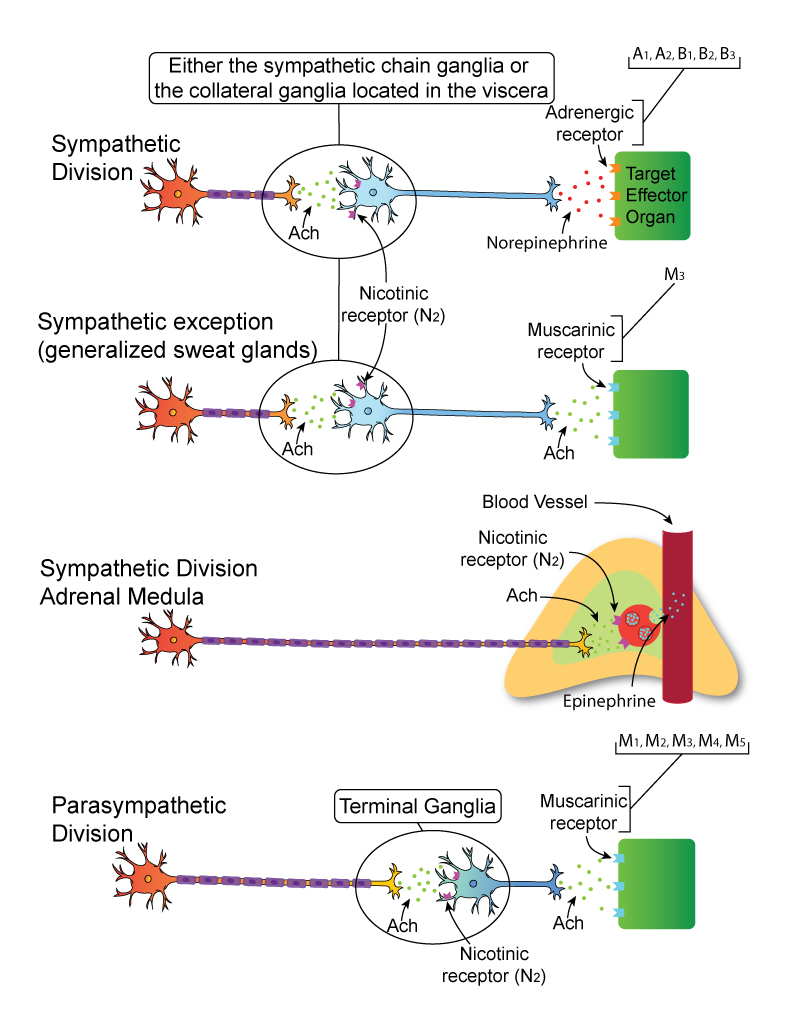AUTONOMIC NERVOUS SYSTEM
PHYSIOLOGY OF THE ANS
Overview
As discussed previously, nerves of the ANS extend from the CNS to smooth, or cardiac muscle, organs, and glands via a two neuron system-; namely a preganglionic neuron and a postganglionic neuron. In this system, there are 2 synapses-; one separating preganglionic and postganglionic neurons, and the other between the postganglionic neuron and effector (see figure below). The preganglionic neuron releases neurotransmitters stored in synaptic vesicles of axon terminals. An action potential reaching the axon terminal causes release of these stored neurotransmitters into the synaptic cleft. After crossing the synapse, neurotransmitters bind to receptors imbedded in postganglionic cell membranes (see figure below). This binding depolarizes the postsynaptic cell membrane (EPSP) and results in action potentials. Action potentials arriving at the axon terminal lead to release of neurotransmitters into the synaptic cleft, separating the postganglionic neuron and effector (neuro-effector junction). Finally, binding of neurotransmitter to the receptor expressed on effector cells can result in excitation or inhibition of the effector. Sympathetic and parasympathetic divisions differ in the types of neurotransmitters they release and the receptors and second messenger systems they express.

Image by Nate Shoemaker Spring 2016
ANS preganglionic and postganglionic neurons and locations of ANS receptors. Nicotinic receptors are located on the postganglionic neurons of the sympathetic and parasympathetic cell bodies. Nicotinic receptors respond to the binding of acetylcholine (ACH), which causes an excitatory effect. Muscarinic receptors are located on all parasympathetic effector cells and some (generalized sweat glands) sympathetic effector cells. Muscarinic receptors respond to the binding of ACH, and may have an excitatory or inhibitory effect. Adrenergic receptors are located on most sympathetic effector cells. Adrenergic receptors respond to the binding of norepinephrine (NE), which may have an excitatory or inhibitory effect.
Neurotransmitters of the ANS
Neurotransmitters are chemicals that travel across the synapse connecting two neurons, or between a neuron and an effector. For example, when we discussed the neuromuscular junction we were talking about a neuron-effector synapse and the neurotransmitter used was acetylcholine (ACH). ACH is also one of the neurotransmitters used by the ANS. Cholinergic neurons produce ACH and store ACH in their synaptic terminals. The preganglionic neuron for both parasympathetic and sympathetic nervous systems is cholinergic. The postganglionic neuron of the parasympathetic division is also cholinergic. The postganglionic neuron for the sympathetic division is usually an adrenergic neuron which means that it produces norepinephrine (NE) as its neurotransmitter. Sympathetic postganglionic neurons innervating sweat glands and some blood vessels are the exception-; they are cholinergic and release ACH.
Receptors of the ANS
Usually a particular receptor subtype for each division of the ANS will dominate in a certain gland or organ. In general, activation of some receptor subtypes lead to stimulation of the effector and activation of others to inhibition of the effector. Even numbered subtypes are usually inhibitory and odd numbered subtypes are usually excitatory, but there are no hard and fast rules. Ultimately, the relative amounts of each receptor subtype expressed in the tissue will determine the overall effect (stimulation or inhibition) on the particular gland or organ.
Cholinergic Receptors
As mentioned, preganglionic neurons of both sympathetic and parasympathetic divisions produce and release ACH. The receptors for ACH are known as cholinergic receptors. There are two main subtypes of cholinergic receptors-; nicotinic and muscarinic. They are named after alkaloids found in tobacco and certain mushrooms respectively. The alkaloid nicotine specifically activates nicotinic cholinergic receptors, while muscarine activates muscarinic cholinergic receptors, and ACH activates both types. The cell bodies of postganglionic neurons for both sympathetic and parasympathetic nervous systems express nicotinic receptors (see figure above). To distinguish nicotinic receptors in neurons from nicotinic receptors found in the neuromuscular junction, we use the terms nicotinic neural (NN or N2) cholinergic receptors and nicotinic muscle (NM or N1) cholinergic receptors respectively. Muscarinic receptors (M) are located on cells of all parasympathetic effectors and on cells of some sweat glands innervated by the sympathetic nervous system. There are several subtypes of muscarinic receptors (M1-M5) which may be stimulatory or inhibitory.
Adrenergic Receptors
As mentioned, neurons that produce and release the neurotransmitter NE are known as adrenergic neurons. NE is secreted by postganglionic neurons of the sympathetic nervous system and binds to adrenergic receptors expressed on effector cells. Epinephrine (EPI) released by the adrenal gland also binds to adrenergic receptors expressed on effectors (see figure above). There are two main types of adrenergic receptors, namely, alpha and beta which have several subtypes. For our purposes, we will focus on the following four subtypes: alpha 1, 2, and beta 1, 2, and 3. Activation of adrenergic receptors expressed on effectors by NE or EPI may result in stimulation or inhibition of the effector depending on the tissue involved. Odd subtypes of adrenergic receptors (alpha 1, and beta 1, and 3) generally have stimulatory effects and even subtypes (alpha 2 and beta 2) have inhibitory effects. The next section explores the effects of a ligand binding to its receptor in a particular tissue.
**You may use the buttons below to go to the next or previous reading in this Module**


